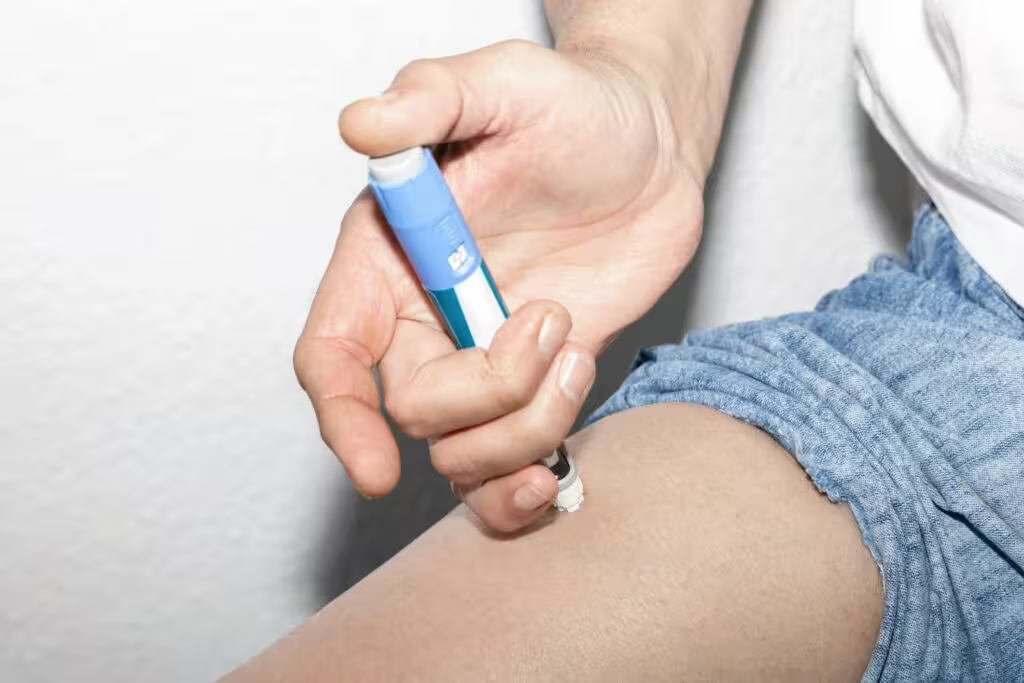Ozempic, Mounjaro, and EMS: The Smart Way to Lose Weight Without Losing Muscle
How to pair Ozempic/Mounjaro with EMS so you lose fat, not muscle – safe, simple, and coach-guided in Chicago.

TL;DR
GLP-1 medicines (Ozempic/Wegovy; Mounjaro/Zepbound) can drive big weight loss – but part of that loss can be lean mass. Add a weekly 20-minute, coach-led EMS session plus a clear protein target and gentle cardio, and you’ll protect strength while the scale moves down. Start conservatively, hydrate, and loop in your clinician if you use insulin or have medical flags. Register now.
You’re doing something big – using a GLP-1 to take control of your weight. Now let’s make sure the weight you lose is mostly fat, not hard-earned muscle. This guide shows how EMS training in Chicago can fit alongside Ozempic/Wegovy (semaglutide) and Mounjaro/Zepbound (tirzepatide) to keep you strong, safe, and consistent.
First, what these medicines actually do
- Ozempic (semaglutide) is FDA-approved for type 2 diabetes (and to reduce major cardiovascular events in T2D), while Wegovy (semaglutide 2.4 mg) is approved for chronic weight management.
- Mounjaro (tirzepatide) is FDA-approved for type 2 diabetes; Zepbound (tirzepatide) is approved for chronic weight management – and for obstructive sleep apnea in adults with obesity.
These drugs curb appetite and slow gastric emptying, making it easier to eat less. That’s the win. The catch: when weight drops fast, some lean mass can go with it.
The muscle-mass catch (and why it matters)
In a semaglutide body-composition substudy, people lost more fat mass than lean mass, but lean mass did drop (~9–10%), even as the percentage of lean mass relative to body weight slightly rose. Reviews across GLP-1 trials suggest ~20–40% of lost weight can be lean mass – a normal part of dieting, but still worth addressing. Less muscle can mean a lower metabolism, weaker performance, and tougher long-term maintenance.
Where EMS fits
Whole-body EMS (the suit you wear during a guided 20-minute workout) gives your muscles a strong, joint-friendly stimulus without long gym sessions. Meta-analyses show EMS can increase lean mass and strength in non-athletic adults. In studies where EMS was added to dieting, maintaining lean mass while losing fat was more achievable. That’s exactly what you want on a GLP-1: lose fat, keep muscle.
At Fit in 20, sessions are coach-led, short, and scaled to your comfort – so you get the stimulus you need without beating up your joints.
Your simple plan to lose fat and keep muscle
Use this as a starting point. We’ll tailor it around your meds, schedule, and how you feel.
- Keep a weekly strength “anchor”
- 1× 20-minute EMS session/week (48–72 hours from your hardest activity). If you’re already lifting, EMS acts like a high-yield accessory day; if you’re not, EMS is your strength anchor.
- Hit a protein floor – even with low appetite
- Aim for 1.4–2.0 g/kg/day (~0.64–0.9 g/lb) from real food first; use shakes when appetite is low. Spread protein over meals (roughly 20–40 g each). This intake range is well-supported for active people to preserve muscle in a deficit.
- Hydrate and pace yourself
- GLP-1 labels warn about dehydration and kidney stress in the setting of persistent nausea/diarrhea – so sip fluids, add electrolytes on hot days, and flag persistent GI symptoms to your clinician. We’ll keep intensity modest if you’re queasy.
- Time sessions around how you feel
- Many people feel more GI effects right after dose increases. Book EMS on a day you typically feel steadier. That’s not a rule – just kinder to your body (and consistency).
- If you use insulin or a sulfonylurea
- GLP-1s alone rarely cause hypoglycemia, but combining them with insulin or sulfonylureas can. Bring a quick carb, monitor your glucose, and talk to your prescriber about dose adjustments as weight and intake change.
- Add light movement for recovery and calories
- Short walks, easy cycling, or swimming on non-EMS days help energy, mood, and appetite regulation without beating you up. Major guidelines support regular activity plus 2–3 days/week of muscle-strengthening work.
A week that works (example)
- Mon: Dose day (if that’s your rhythm) + 20–30 min easy walk.
- Tue: EMS 20-minute session (coach-led), then 10–15 min easy cardio.
- Wed: Walks or gentle mobility (10–30 min).
- Thu: Optional light gym circuit or another easy cardio bout.
- Fri: Walks + core work.
- Sat/Sun: Family activity or short hike.
- Protein with each meal; hydrate throughout. Adjust up/down based on how you feel and what your clinician recommends.
When to check with your clinician first
- You’re on insulin/sulfonylureas (glucose plan may need tweaks).
- You’ve had pancreatitis, significant kidney issues, or gallbladder disease symptoms on a GLP-1.
- Pregnancy or planning to conceive.
- For EMS specifically: implanted electronic devices (e.g., pacemaker) or other standard EMS contraindications – ask us and your doctor first.
Why this works (the psychology bit)
- Make it easy: 20 minutes removes the “no time” excuse.
- Make it specific: One weekly EMS appointment is a commitment device – show up, get the stimulus.
- Make it reinforcing: Strength gains and better posture are fast feedback that keep you engaged while the scale is doing its thing.
- Make it social: Small-group training gives you a coach and a training buddy – consistency loves accountability.
What to expect at Fit in 20 (Chicago)
- Coach-supervised EMS using FDA-cleared muscle-conditioning equipment, scaled to your comfort.
- Short, efficient sessions (~20 minutes) that recruit many muscle groups at once.
- Everything provided: suit, shorts, top, and water – just bring training shoes.
- Start conservative – especially if you’re early in your GLP-1 journey or recently changed dose.
Ready to protect your muscle while you drop fat? Register now ↓
Register for a free trial session
Experience an innovative training method that makes every moment count. Energize your body, build strength, and see how training in the suit can fit perfectly into your week.
First session free (~30 min)


.avif)

